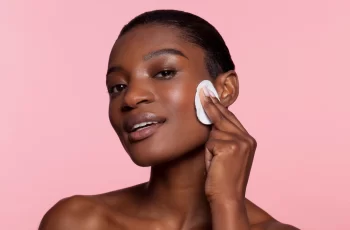Another day, another buzz ingredient making waves in the skincare industry, matrixyl is one new kid on the block we would all benefit from. Now I can hear the questions rushing around your head as I type this, don’t worry as I’ll make things a lot clearer by the end of today’s blog post. Let’s start off by explaining what matrixyl is and how it works for the skin.
What is matrixyl?
Matrixyl is the brand name of the anti-ageing peptides synthetically produced to be formulated into skincare products. You’ll find that matrixyl is a combination of Palmitoyl Tripeptide 1 and Palmitoyl Tetrapeptide 7, both these peptides act as the building blocks for the skin helping to form the structure and boost the production of collagen. This is vital for maintaining the health and appearance of the complexion. By the time we reach our mid-twenties it is understood that the levels of collagen begin to deplete by 1% each year.
The clever way matrixyl works is by stimulating the growth of elastin, collagen, and natural hyaluronic acid found in the body. Working in the skin it can reduce the appearance of fine lines and wrinkles leaving the complexion plumped, firmer, with a youthful bounce.
Another bonus to using matrixyl is the fact that anyone can use it. The only concern you may have been ensuring your skin is happy with the other ingredients it’s blended with. There is one ingredient that shouldn’t cause you too much problem, and that’s niacinamide.
What is niacinamide?
A form of vitamin B3, niacinamide delivers results for almost every skin type, including those prone to sensitivity. With its unique properties drawing moisture into the skin and locking it into place, it is also able to regulate sebum production. This makes niacinamide and highly beneficial ingredient for those prone to acne leaving the skin hydrated and nourished, something that those suffering from frequent breakouts miss out on due to overuse of harsh exfoliants and potent formulas.
If you wanted to know more about niacinamide, you can check out our dedicated blog post over on Beauty Insiders.
Now, we have had a refresher on both actives, we can move on to finding out whether you can use matrixyl and niacinamide at the same time.
What can you not mix with matrixyl?
As effective as matrixyl is for the skin, it does come with some precautions with other ingredients, such as vitamin C, also known as L-ascorbic acid, BHA, such as salicylic acid and other acids, like the popular AHA, glycolic acid.
It’s thought best to avoid using these ingredients together due to the over-exfoliation that will occur in you combine them all together. With matrixyl being considered safe enough to be used by all skin types, it is important for you to remember that matrixyl works on the skin in a similar way to retinol. By increasing the skin cell turnover, whilst the ingredient isn’t technically exfoliating the skin, if you apply an exfoliating formulation on the skin after you will overstimulate the skin, cause imbalance to the pH levels, and result in flare-ups and redness.
Can I use matrixyl and hyaluronic acid together?
You certainly can use matrixyl and hyaluronic acid together. Each active ingredient is perfectly effective to use on their own, but even more effective combined. With hyaluronic acid attracting over 1,500 times its weight in water locking it into place whilst penetrating the lower layers of the dermis. Team this with matrixyl boosting production of collagen and hyaluronic acid in the skin, your complexion is left boosted in hydration. Teaming the two together are especially effective during the winter months to counteract any excessive dryness. A bonus is the fact that both ingredients help to regulate the skin sebum levels in the skin preventing any further breakouts.
Can I use matrixyl and retinol together?
Not really, and this is only because they both benefit the skin in similar ways. If you layer matrixyl and retinol on top of each other this will lead to negative side effects, such as redness, flaking skin, itchiness, dryness, and irritation. It is important to build your skin’s tolerance by introducing retinol slowly into your daily routine.
For the best results without the side effects, I would suggest applying each ingredient on alternative days, this will help you reap the rewards of the powerhouse actives. With both matrixyl and retinol increasing the skin cell turnover, it is particularly important to ensure you apply a daily SPF to protect the face from exposure to free radicals, such as UV rays, pollution, central heating, and other environmental aggressors.
Can matrixyl be used around the eyes?
Yes, you can! You’ll find that the eye area is considerably thinner than the rest of your skin. This often leads to the eye area showing signs of ageing, such as fine lines, wrinkles, and undereye puffiness. By applying matrixyl to the under-eyes you will help boost the hydration, reducing the appearance of lines as well as improving the look of the under-eye bags that can look worse in the mornings due to fluid retention or dehydration.
Can I mix niacinamide with peptides?
Yep, it is considered perfectly safe to mix niacinamide and peptides together. Using a mixture of these two powerhouses will result in the skin’s lipid barrier maintaining the correct levels of water and oil ensuring it is strengthened and able to protect the skin surface from exposure to harmful free radical damage. There’s more to learn about mixing niacinamide and peptides together on our blog post. There you have a little insight into how to use niacinamide and matrixyl at the same time. Even if you have already used these ingredients and have a well-established routine, it is always a good idea to consult with a doctor or dermatologist to ensure you are using the best ingredients for you and your skin’s needs. If you have any further questions you can come and find me over on the Procoal Instagram, look forward to seeing you there.



